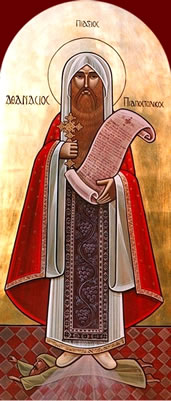Sozomen
In the last years of the fourth or first years of the fifth century, Sozomen was born in Bethelia, near Gaza, into a family of committed Christians. He most likely received some education from local monks, and they became a source for his later historical work. There is no evidence that Sozomen actually practiced a monastic life himself, however. At some point after the death of bishop Atticus of Constantinople (425), Sozomen settled in Constantinople. He appears to have been involved in the legal profession and was a strong proponent of the Nicene faith.
Sozomen composed his Historia Ecclesiastica between 439 and 448. The work was intended to cover the period from the third consulship of Crispus and Constantine in 323 until the seventeenth consulship of Theodosius II in 439. However, Sozomen did not complete his 9th and final book, so his work ends with the events of 425. The reason he did not finish is unknown.
As was common at that time, Sozomen rarely names or credits his sources. Much of his history is, however, clearly taken from that of Socrates Scholasticus (Rohrbacher, 122). Sozomen sought to improve the simple style of Socrates with more eloquent diction and to correct what he saw as broad stylistic and thematic flaws. Only occasionally does he include entire documents in his history. Rather, he usually provides abridged paraphrases, as he indicates in his preface (1.1.15). This allowed him to have more control over the flow of thought. He also attempts to remain unbiased when presenting theological controversies. Sozomen’s work displays more interest in monastic activity than Socrates’s work does, as is shown by his inclusion of biographies of famous monks. In addition, Sozomen’s great interest in the spread of Christianity outside the Roman Empire, and in the eastern Sassanian realms in particular, sets him apart from all the other continuators of Eusebius.
Church History
| Incipit: | Φασὶ τῶν πάλαι αὐτοκρατόρων ἐπιμελές τι χρῆμα γενέσθαι |
| Date: | 439-448 |
| CPG: | 6030 |
| TLG: | 2048.001 |
| Earliest ms: | Alexandria, Patriarchal Library, Alex. 60 (Cairo 86). |
| Early editions: | Stephanus, Ecclesiasticae historiae . . . Hermii Sozomeni libri IX (Paris 1544).H. Valesius, Socratis Scholastici et Hermiae Sozomeni Historia ecclesiastica (Paris 1668). |
| Early versions: | Latin excerpts: in the Historia Tripartita of Cassiodorus/Epiphanius (ed. W. Jacob, and R. Hanslik, CSEL 71 (Vienna 1952). |
| Most recent Greek edition: | G.C. Hansen, Sozomenus Kirchengeschichte, 2nd ed., GCS Neue Folge 4 (Berlin 1995). |
| English translation: | C. Hartranft, “The Ecclesiastical History of Sozomen,” in NPNF2, Vol. 2 (New York, 1890), pp. 179-427. A revised translation by Kevin Knight is available online here. |
Sozomen’s account of the Nicene Council
Bibliography:
Labate, A. “Sozomen.” In Encyclopedia of Ancient Christianity. Edited by Angelo Di Berardino. Downers Grove, IL: InterVarsity Press, 2014. pp. 622-623.
Norris, Frederick W. “Sozomen.” In Encyclopedia of Early Christianity. Edited by Everett Ferguson. New York: Garland Publishing, Inc, 1990. p. 864.
Rohrbacher, David. The Historians of Late Antiquity. London: Routledge, 2002. pp. 117-125.
Created by OT 2-18-17
No Responses yet
